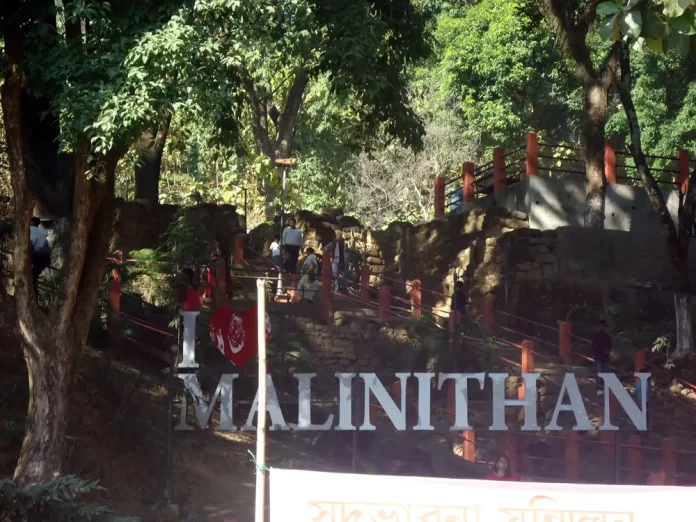[Amar Krishna Paul]
Let’s start with a beautiful statement of Dr APJ Abdul Kalam, former president and the Missile Man of India. He opines in an analytical article in the Bhagavatam Sevarpanam: “Spirituality is the postgraduate study of religion and we should rise from religion to spirituality.”
That is, we have a glorious past from a spiritual point of view. We should preserve our over 5,000 years old civilisation. A part of our ancient glory can be witnessed even today at Malinithan in the foothills of Likabali in Lower Siang district of Arunachal Pradesh. It is only 7 kilometres away from Silapathar town in Dhemaji district of Assam.
Situated amid picturesque and lush grassy greenery, Malinithan is also known as ‘Malini-sthaan’ or the ‘Abode of Malini’. Historically, it is one of the oldest temples of India, an archeological site and famous pilgrimage destination in the northeastern region of the subcontinent.
The temple is situated on a hill that rises to a height of 21 metres, and offers a commanding view of the plains around it, including the Brahmaputra river, and the site is visited by thousands of devotees and tourists.
Of late, the temple has been renovated by the government of Arunachal. The active members of the Malinithan Vikash Parishad are doing a highly commendable service. They are organising the much-attended Malinithan Mela, an annual tourism festival, from 10 to 14 January, 2024. Celebrations like Malini Mela, with participation of all, including people from neighbouring states, will promote cross-border cultural exchange for peaceful coexistence, communal harmony and brotherhood for all-round development of the state and the region.
This tourist destination has many relics on stones with ruins of temples and valuable sculptures. These are associated with the legendary love story between Lord Krishna of Dwaraka, Gujarat, and Rukmini, princess of erstwhile King Bhismaka of Kundilnagar, near Roing divisional town of Dibang Valley district of Arunachal.
The site has a temple ruin dating back to 10th and 14th century AD of rich sculptural and architectural value. Beautifully designed and decorated basement of temple, divine images, icons and deities, animal motifs and floral designs, carved columns and panels have been unearthed.
According to established scriptural injunctions, on the way to Dwarka from Bhismaknagar, Krishna and Rukmini rested here. They were offered choicest flowers by Malini, who is also known as Maa Durga.
There is a very interesting legend of Lord Krishna, his consort Rukmini, Lord Shiva and Parvati associated with it. As per legend, here was an ancient kingdom called Vidarbha or Bhismaknagar, which was ruled by king Bhismaka (located near Roing, Lower Dibang Valley). King Bhismaka had a son and daughter named Rukma and Rukmini. Rukmini fell in love with Krishna, but her brother wanted her to marry his childhood friend Shishupala, the prince of Chedi.
After knowing about Rukmini’s proposed marriage to Shishupala against her will, Krishna travelled to Bhismaknagar and eloped with Rukmini before her marriage. On their way from Bhismaknagar to Dwarka, they rested in this place with a beautiful garden where Lord Shiva and Parvati were spending some time together. Lord Shiva and Parvati greeted Lord Krishna and princess Rukmini with a warm welcome and garlands made of beautiful flowers from their garden. Lord Krishna was highly amazed by the eternal fragrance of the flowers, and addressed Parvati as ‘Sucharu Malini’. This means a lady who strings garlands beautifully. Thus, the site was named Malinithan.
“Malinithan was a cultural centre of Northeast India in the remote past,” stated a release from Arunachal Tourism.
After Kamakhya temple in Guwahati, Malinithan is one of India’s most famous shakti peethas. The people of the region had attempted to construct a cultural bridge between the hills and the plains through the holy centre of Malinithan from the early mediaeval period. It was once an important religious centre of Aryan culture, from where the wave of Aryan civilisation spread to other parts of its neighbourhood. Malinithan temple was most likely constructed in 1968.
Dashabhuja Mahisasurmardini Durga, Surya, Dancing Ganesh, Kartika, and Nandi bull are among the five sculptures made of hard granite stones that have been discovered at the site. Malinithan’s major goddess is Dashabhuja Durga. The Malinithan temple was constructed in Odisha’s classical tradition, with sculptures dating from the 13th and 14th centuries AD.
To attract tourists, the Arunachal government built a museum near the temple, which houses archaeologically significant sculptures and other items.
On 24 November this year, a media report said that, as many as 15 destinations in the Northeast have been selected for development under the central government’s Swadesh Darshan 2.0 scheme, aiming to boost tourism in the region rich in cultural and natural heritage. These include one from Manipur and two each from the seven other states in the Northeast. The move aims to not only boost tourism in the eight states but also help in further development in the region.
The NE states, some of which share borders with other countries, are known for their pristine beauty, blessed with majestic hills, scenic waterfalls, crisscrossing rivers and adventurous treks, and many of these sites have not been explored by domestic tourists. The central tourism ministry officials shared details of the Swadesh Darshan 2.0 scheme and updates on the PRASHAD scheme during the 11th edition of the International Tourism Mart (ITM), held in Shillong (Meghalaya) from 21-23 November.
To sum it up, Malinithan is testimony to the flourishing rich cultural heritage of Arunachal and upper Assam. It is associated with the legendary love story of Lord Krishna and princess Rukmini. The temple of Orrisian architecture of the 10th to 14th century AD reflects as a leading centre of shaktism as well.
According to a report on Republic TV news channel, over 60 per cent of the total tourists of the country make their travels to religious sites. Therefore, the union tourism ministry may formulate a goal-driven comprehensive plan to promote Malinithan as a major tourist destination like Kamakhya dham of Guwahati in the upcoming International Tourism Mart in 2024. This move will not only generate employment avenues, it will also boost the state’s border economy as a whole. (The contributor is a Guwahati-based writer and analyst on current affairs. He may be reached at amarkrishnaghy@gmail.com. The views expressed are personal.)


